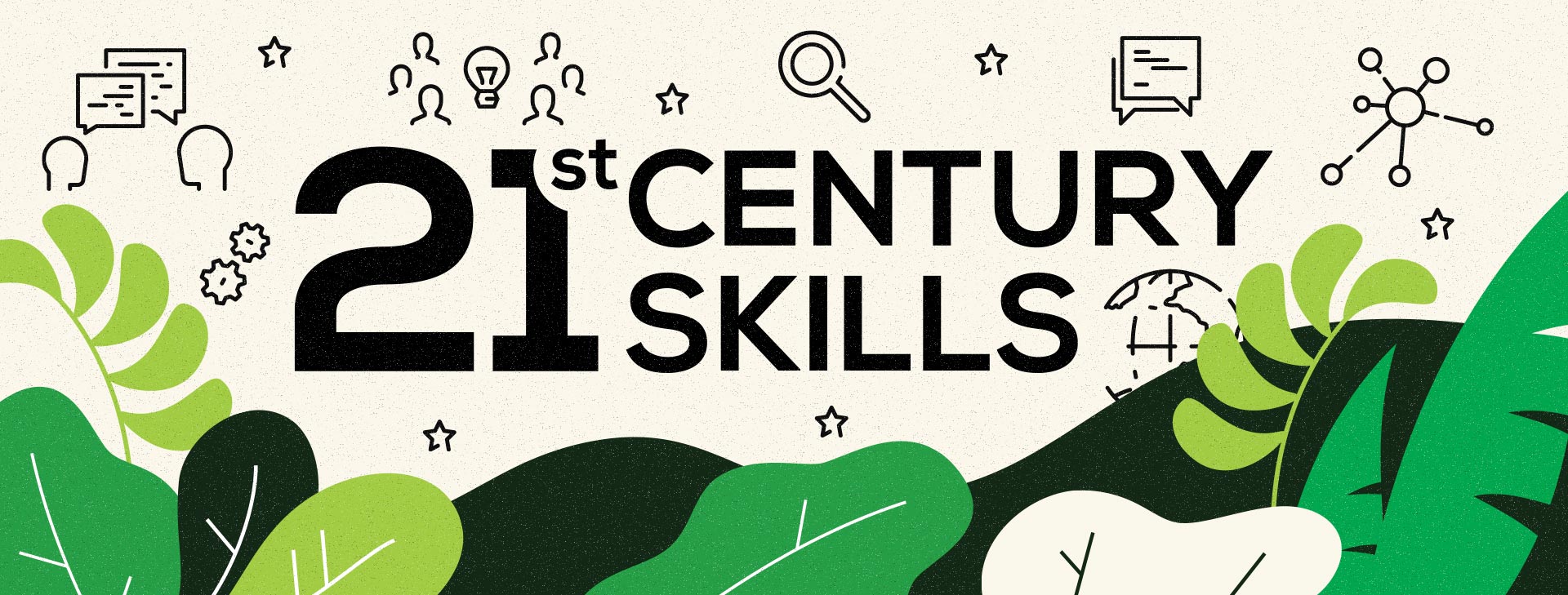
Instructing & Assessing 21st Century Skills: A Focus on Creativity
Research and Best Practices: One in a Series on 21st Century Skills
For the full collection of related blog posts and literature reviews, see the Center for Assessment’s toolkit, Assessing 21st Century Skills.
Creativity is a multidimensional construct that has been considered from different perspectives and disciplines. There is not just one way for a person to be creative or one set of characteristics that differentiate the creative person. In this post, I rely on what is known from the research to (1) define creativity; (2) discuss how creativity develops over time; (3) describe how classroom-based instruction and assessment can be applied to nurture creativity; and (4) provide recommendations for assessment design and use.
What is Creativity?
Plucker, Beghetto, & Dow (2004) propose a clear and useful definition of creativity for educators:
Creativity is the interaction among aptitude, process, and environment by which an individual or group produces a perceptible product that is both novel and useful as defined within a social context (p. 90).
Creativity includes both general and context-specific knowledge, skills, and dispositions. Moreover, judgments of creativity can occur through multiple lenses, which are often characterized in relation to four “Ps” (Rhodes, 1961):
- The person: personality features and dispositions of an individual
- The process: the observable learning and thinking involved in a creative act
- The product: something that gets produced through the creative process
- The press: the environment and other social factors that influence the creative process
Each creative component – person, process, product, and press – includes a range of sub-components that can be taught and learned (Patston et al., 2021), and that influence an individual’s creative potential.
Each person has individual qualities and attributes that play a key role in the development of creative skills and capacities. Examples of these attributes include curiosity, resilience, openness to new experiences, willingness to take sensible risks, and a tolerance for ambiguity.
The creative process involves concrete skills and strategies that are set into motion with an initial problem or question. Possible answers and solutions are generated and later selected through both divergent (idea generation) and convergent (critical selection) thinking strategies. Throughout the process, ideas and possibilities are analyzed from multiple perspectives, new or unexpected connections are established, and alternative solutions are considered and selected for implementation.
The product provides evidence for evaluating the creativity of a person or product within a social context. Thus, understanding how social and contextual factors influence judgments of creativity is essential in developing creative potential.
And the press, including numerous physical environmental, and psychological factors, can be manipulated to either enhance or inhibit creativity within an individual or environment (e.g., the classroom).
The Development of Creativity
Kaufman and Beghetto (2009) presented a developmental progression of creativity over the lifespan. Their 4C Model is a framework for conceptualizing levels of creative expression, and it introduces several potential paths of creative development. Most K-12 students demonstrate creative processes and products representative of the first two categories: Mini-c and Little-c creativity.
Mini-c creativity: Mini-c creativity occurs as an individual learns something new. It represents a person’s creative process of constructing personal knowledge and accommodating new information to generate new understandings. For example, a student proposes a viable way to solve a problem but struggles to communicate why it is the best solution.
Little-c creativity: School-age learners often work at Little-c level if they engage in purposeful practice in a subject area or sporting event. For example, a student may demonstrate Little-c creativity when they solve a complex problem, create a poem or short story, compose a song during music practice, or find a better way of positioning their body when preparing to hit a baseball. At Little-c, creativity becomes a worthy goal in its own right, regardless of how a product is judged by an external audience.
Pro-c creativity: Pro-c creativity represents individuals who are “professional” creators—they apply creative thinking in a profession—but have not reached eminent status.
Big-C creativity: Big-C creativity is reserved for unimpeachable eminence regarding the creative contribution, such as by classical composers (e.g., Beethoven), scientists (e.g., Einstein), Pulitzer Prize winners (e.g., Doris Kearns Goodwin), and historical figures (e.g., Franklin D. Roosevelt).
Pedagogy That Supports the Development of Creativity
Although more research is needed to fully understand the impact of instructional approaches on students’ creativity, several studies (e.g., Amabile, 1988; Cremin & Chappell, 2021; Davies, 2013) offer preliminary guidance for educators. Studies suggest that the following practices nurture students’ creativity:
- Generating and exploring ideas in a psychologically safe environment
- Encouraging autonomy and agency by prioritizing choice and providing time for students to experiment with ideas
- Making learning fun by balancing spontaneity and freedom with goal-oriented aims and rules
- Solving complex problems through authentic and extended projects with real-world experts
- Encouraging risk-taking; for example, when a teacher models how to approach a task, experiment with possible solutions, and practice resilience before stepping back and providing support to students as needed
- Co-constructing ideas and collaborating with the teacher, professional experts, and other students
- Modeling creativity by thinking aloud and prioritizing discussion and critique
Are Assessment and Creativity Fundamentally at Odds?
The answer is no—when assessment is delivered and used effectively. An assessment’s effectiveness in nurturing creativity depends on its intended purpose and use. Assessment tends to suppress creativity when it is used— or perceived to be used—to
- influence competition and comparisons among students,
- motivate performance (i.e., using grades to reward or punish), or
- as a summative evaluation of a student’s work product or thinking process.
Using assessments in these ways can cause anxiety, undermining students’ motivation and capacity for creativity (Bolden et al., 2020; Henessey & Amabile, 1987).
Moreover, high-stakes testing can discourage instruction that supports creativity and creative thinking, especially in low-performing schools. The pressure to raise scores on such tests can intensify a focus on drill-and-kill skills, influence more traditional and rigid instruction, detract from activities that encourage exploration and discovery, and discourage teachers and students from focusing on higher-order skills like critical thinking and problem-solving (Jones et al., 2003; Guthrie, 2002).
A large body of research shows that formative assessment, or assessment for learning, is a powerful tool for improving instruction and learning (Black & Wiliam, 1998; Hattie, 2008) and, importantly, for nurturing and enhancing students’ creative potential.
Teachers evoke students’ creative potential by using a variety of assessment tools and strategies to (a) provide frequent, descriptive, and detailed feedback, (b) highlight areas of creative strength and opportunities for creative growth, and (c) provide opportunities for student self-assessment and reflection. Therefore, it behooves educators to develop or adopt explicit definitions of creativity, and to select a range of assessments of creativity that produce holistic evidence and that align with these accepted definitions.
Implications for Classroom Assessment Design and Use
Many of the instruction and assessment lessons that emerged from our review of other 21st Century skills apply to creativity. Like most 21st Century skills, there are no precise end-of-grade level or end-of-grade span proficiency standards or empirically validated learning progressions for creativity.
Consequently, it is unclear how students develop competence in the domain of creativity. There are no expected levels of creativity at certain markers in time or within specific contexts or subjects. There do exist, however, a few research-based learning frameworks of how students demonstrate less- to more- sophisticated forms of creativity, among other success skills (e.g., Lucas et al., 2012; OECD, 2020; Ramalingam et al., 2020). These learning frameworks are analytic and multi-dimensional (typically involving four or five levels of student performance), but they are not broken down by grade level.
An additional challenge with assessment use relates to rubrics. Rubrics entail scoring and grading, and grading can have negative effects on learning (Shepard, 2019)—especially for creativity (Amabile, 2020). We at the Center recommend that the evaluative language of a rubric not be used (Evans, 2020; Thompson, 2020). Instead, we believe that research-based continua are needed that describe creativity from less to more sophisticated. These continua would be pilot tested on student work in local contexts to evaluate the extent to which they accurately reflect how students across socio-cultural contexts and conditions demonstrate competence in the domain. As part of our work with PBLWorks, we created draft continua for 21st Century Skills (including continua for creativity), which should be piloted soon in classrooms.
These continua should provide useful, formative information that teachers could use during creative problem-solving activities to guide instruction and provide feedback to students. Pilot testing will determine if the continua provide useful feedback to students, parents, and teachers for instructional purposes. For example, being given specific behaviors to look for during creative problem-solving activities would help teachers know what skill to teach.
Further, students could keep these behaviors in mind as they work to improve their creativity skills. Annotated student work samples from across disciplines and types of assessment tasks would be especially useful in helping teachers recognize markers (i.e., learning milestones) for the essential dimensions of creativity in student work products and artifacts.
Conclusion
Treffinger (2009) suggested, rather than “how creative are you?” a more meaningful question is “how are you creative? Individuals vary not only in their level of creativity but in their style of creativity as well (e.g., Selby et al., 2004). Effective assessment of creativity involves a profile of aptitudes, skills, behaviors, and motivations, which can make assessment of creativity a challenging endeavor, particularly in classroom settings where time is a scarce commodity.
Nonetheless, extensive research suggests that measuring and assessing creativity is not only possible; it can be used in powerful ways to develop and optimize the creative potential of students. Doing so requires gathering data from multiple sources to understand the richness and breadth of creativity, in an appropriate context, and for appropriate purposes.
The Center for Assessment partnered with PBLWorks to provide tools and resources supporting project-based instruction and assessment of 21st century skills.
